Immaggine:PIA23791-Venus-RealAndEnhancedContrastViews-20200608 (cropped).jpg
Câa

Dimenscioìn de st'anteprìmma chi: 600 × 600 pixel. Âtre resoluçioìn: 240 × 240 pixel | 480 × 480 pixel | 768 × 768 pixel | 1 096 × 1 096 pixel.
File òriginâle (1 096 × 1 096 pixel, dimensción do file: 30 KB, tîpo MIME: image/jpeg)
Cronologîa do file
Sciàcca in sce 'n grùppo dæta/ôa pe védde comm'o l'êa o file into moménto indicòu.
| Dæta/Ôa | Miniatûa | Dimenscioìn | Uténte | Coménti | |
|---|---|---|---|---|---|
| prezénte | 00:40, 10 lùg 2020 |  | 1 096 × 1 096 (30 KB) | PhilipTerryGraham | File:PIA23791-Venus-RealAndEnhancedContrastViews-20200608.jpg cropped 51 % horizontally using CropTool with precise mode. |
Utilìzzo do file
A pàgina chi de sótta a contêgne di ligàmmi a sto file chi:
Utilìzzo globâle do file
Quésto file o l'é dêuviou da 'ste âtre wiki ascì:
- Dêuviòu inte pàgine de ary.wikipedia.org chi de sótta:
- Dêuviòu inte pàgine de arz.wikipedia.org chi de sótta:
- Dêuviòu inte pàgine de ast.wikipedia.org chi de sótta:
- Dêuviòu inte pàgine de as.wikipedia.org chi de sótta:
- Dêuviòu inte pàgine de awa.wikipedia.org chi de sótta:
- Dêuviòu inte pàgine de azb.wikipedia.org chi de sótta:
- Dêuviòu inte pàgine de az.wikipedia.org chi de sótta:
- Dêuviòu inte pàgine de ban.wikipedia.org chi de sótta:
- Dêuviòu inte pàgine de bat-smg.wikipedia.org chi de sótta:
- Dêuviòu inte pàgine de ba.wikipedia.org chi de sótta:
- Dêuviòu inte pàgine de bcl.wikipedia.org chi de sótta:
- Dêuviòu inte pàgine de be-tarask.wikipedia.org chi de sótta:
- Dêuviòu inte pàgine de be.wikipedia.org chi de sótta:
- Dêuviòu inte pàgine de bew.wikipedia.org chi de sótta:
- Dêuviòu inte pàgine de bg.wikipedia.org chi de sótta:
- Dêuviòu inte pàgine de bh.wikipedia.org chi de sótta:
- Dêuviòu inte pàgine de bjn.wikipedia.org chi de sótta:
- Dêuviòu inte pàgine de bn.wikipedia.org chi de sótta:
- Dêuviòu inte pàgine de bo.wikipedia.org chi de sótta:
- Dêuviòu inte pàgine de br.wikipedia.org chi de sótta:
- Dêuviòu inte pàgine de bs.wikipedia.org chi de sótta:
- Dêuviòu inte pàgine de btm.wikipedia.org chi de sótta:
- Dêuviòu inte pàgine de bxr.wikipedia.org chi de sótta:
- Dêuviòu inte pàgine de ca.wikipedia.org chi de sótta:
- Dêuviòu inte pàgine de cdo.wikipedia.org chi de sótta:
- Dêuviòu inte pàgine de ceb.wikipedia.org chi de sótta:
- Dêuviòu inte pàgine de ce.wikipedia.org chi de sótta:
- Dêuviòu inte pàgine de chr.wikipedia.org chi de sótta:
- Dêuviòu inte pàgine de ckb.wikipedia.org chi de sótta:
- Dêuviòu inte pàgine de co.wikipedia.org chi de sótta:
- Dêuviòu inte pàgine de crh.wikipedia.org chi de sótta:
- Dêuviòu inte pàgine de cr.wikipedia.org chi de sótta:
- Dêuviòu inte pàgine de csb.wikipedia.org chi de sótta:
- Dêuviòu inte pàgine de cs.wikipedia.org chi de sótta:
- Dêuviòu inte pàgine de cu.wikipedia.org chi de sótta:
- Dêuviòu inte pàgine de cv.wikipedia.org chi de sótta:
- Dêuviòu inte pàgine de cy.wikipedia.org chi de sótta:
- Dêuviòu inte pàgine de dag.wikipedia.org chi de sótta:
- Dêuviòu inte pàgine de da.wikipedia.org chi de sótta:
- Dêuviòu inte pàgine de de.wikipedia.org chi de sótta:
- Dêuviòu inte pàgine de dga.wikipedia.org chi de sótta:
- Dêuviòu inte pàgine de din.wikipedia.org chi de sótta:
- Dêuviòu inte pàgine de diq.wikipedia.org chi de sótta:
- Dêuviòu inte pàgine de dsb.wikipedia.org chi de sótta:
- Dêuviòu inte pàgine de dty.wikipedia.org chi de sótta:
- Dêuviòu inte pàgine de el.wikipedia.org chi de sótta:
Véddi l'ûzo globâle de quésto file.




